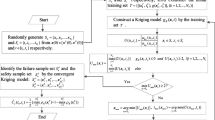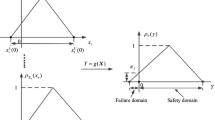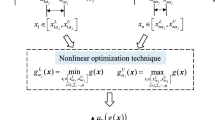Abstract
Failure possibility function (FPF) provides the relationship of failure possibility varying with distribution parameters of fuzzy inputs, and it is desired in the possibility-based design optimization under fuzzy uncertainty. However, estimating FPF by direct double-loop fuzzy simulation (DL-FS) requires large computational cost, since failure possibility needs to be repeatedly estimated corresponding to different discrete realizations of distribution parameters. For addressing this issue, an augmented fuzzy simulation (AFS) is proposed to improve the efficiency of estimating FPF. In AFS, the candidate sample pool (CSP) is first generated in an augmented space spanned by fuzzy inputs and their distribution parameters, on which the failure possibility at different distribution parameters can be estimated by the same CSP of AFS. Compared with DL-FS, the proposed AFS only needs one group of FS, which greatly reduces the computational cost and improves the efficiency of estimating FPF. Moreover, a Kriging model is adaptively embedded in the CSP of AFS by adopting U-learning and CSP reduction strategy, in which the convergent Kriging model trained in CSP of AFS is used to replace performance function for recognizing failure samples and estimating FPF. Since the number of the training samples for constructing the convergent Kriging model is much less than the size of CSP of AFS, the method combining adaptive Kriging with AFS can greatly improve the efficiency of estimating FPF, which is verified by the presented examples.













Similar content being viewed by others
Data availability statement
Data available on request from the corresponding author.
Abbreviations
- FPF:
-
Failure possibility function
- DL-FS:
-
Double-loop fuzzy simulation
- AFS:
-
Augmented fuzzy simulation
- AK:
-
Adaptive Kriging
- CSP:
-
Candidate sample pool
- FS:
-
Fuzzy simulation
- CSP:
-
Candidate sample pool
- PBDO:
-
Possibility-based design optimization
- DLMCS:
-
Double-loop Monte Carlo simulation
- AMCS:
-
Augmented Monte Carlo simulation
- MRE:
-
Mean relative error
- \({\varvec{X}}\) :
-
Fuzzy input vector, and \({\varvec{X}} = \left\{ {x_{1} ,x_{2} ,...,x_{n} } \right\}^{T}\)
- \({\varvec{x}}\) :
-
Realization of \({\varvec{X}}\), and \({\varvec{x}} = \left\{ {x_{1} ,x_{2} ,...,x_{n} } \right\}^{T}\)
- \({\varvec{\theta}}\) :
-
Distribution parameter vector of \({\varvec{X}}\), and \({\boldsymbol{\theta}}= \left\{ {{\boldsymbol{\theta}}_{{X_{1} }} ,{\boldsymbol{\theta}}_{{X_{2} }} ,...,{\boldsymbol{\theta}}_{{X_{n} }} } \right\}^{T}\)
- \({\varvec{\theta}}_{{X_{i} }}\) :
-
Distribution parameter vector of \(X_{i}\)
- \(\pi_{f} \left( {\varvec{\theta}} \right)\) :
-
Failure possibility under given \({\varvec{\theta}}\)
- \(g\left( {\varvec{X}} \right)\) :
-
Performance function
- \(\rho_{{\varvec{X}}} \left( \cdot \right)\) :
-
Joint MF of \({\varvec{X}}\)
- \(\rho_{{X_{i} }} \left( \cdot \right)\) :
-
MF of \(X_{i}\)
- \(\rho_{{\varvec{X}}} \left( { \cdot \left| {\varvec{\theta}} \right.} \right)\) :
-
Conditional joint MF of \({\varvec{X}}\) on \({\varvec{\theta}}\)
- \(\alpha\) :
-
Membership level
- \(F\) :
-
Failure domain, and \(F = \left\{ {g\left( {\varvec{x}} \right) \le 0} \right\}\)
- \(g_{K} {(}{\varvec{x}}{)}\) :
-
Kriging model of performance function
- \(I_{F} \left( \cdot \right)\) :
-
Indicator function of failure domain
- \(S_{{\varvec{x}}}^{(CSP)}\) :
-
Candidate sample pool of fuzzy inputs
- \(\mu_{{g_{K} }} \left( {\varvec{x}} \right)\) :
-
Predicted mean of \(g_{K} \left( {\varvec{x}} \right)\)
- \(\sigma_{{g_{K} }} \left( {\varvec{x}} \right)\) :
-
Prediction standard deviation of \(g_{K} \left( {\varvec{x}} \right)\)
- \({\varvec{\theta}}_{j}\) :
-
Discrete point of \({\varvec{\theta}}\), and \({\varvec{\theta}}_{j} \user2{ = }\left\{ {{\varvec{\theta}}_{{X_{1} }}^{(j)} ,{\varvec{\theta}}_{{X_{2} }}^{(j)} ,...,{\varvec{\theta}}_{{X_{n} }}^{(j)} } \right\}^{T}\)
- \(S_{{{\varvec{\theta}}_{{X_{i} }} }}\) :
-
Candidate sample pool composed of \({\varvec{\theta}}_{{X_{i} }}^{(j)} \left( {j = 1,2,...,N_{{\varvec{\theta}}} } \right)\) in \({\varvec{\theta}}_{j}\)
- \(S_{{I_{F} }}\) :
-
Indicator function set with respect to samples accurately identified by \(g_{K} \left( {\varvec{x}} \right)\)
- \(U\left( \cdot \right)\) :
-
U-learning function
- \(T_{{\varvec{x}}}\) :
-
Training sample set
- \(i\) :
-
\(i = 1,2,...,n\); \(n\) Is the dimension of fuzzy input vector
- \(j\) :
-
\(j = 1,2,...,N_{{\varvec{\theta}}}\); \(N_{{\varvec{\theta}}}\) Is the number of discrete points of \({\varvec{\theta}}\)
References
Schuller GI, Jensen HA (2008) Computational methods in optimization considering uncertainties–an overview. Comput Methods Appl Mech Eng 198(1):2–13
Shi Y, Lu ZZ, Zhou YC et al (2020) A novel time-dependent system constraint boundary sampling technique for solving time-dependent reliability-based design optimization problems. Comput Methods Appl Mech Eng 372:113342
Shi Y, Lu ZZ, Huang ZL et al (2020) Advanced solution strategies for time-dependent reliability based design optimization. Comput Methods Appl Mech Eng 364:112916
Wang C, Matthies HG (2019) Epistemic uncertainty-based reliability analysis for engineering system with hybrid evidence and fuzzy variables. Comput Methods Appl Mech Eng 355:438–455
Zadeh LA (1965) Fuzzy sets. Inf Control 8(3):338–353
Nahmias S (1978) Fuzzy variables. Fuzzy Sets Syst 1:79–110
Mourelatos ZP, Zhou J (2005) Reliability estimation and design with insufficient data based on possibility theory. AIAA J 43(8):1696–1705
Wang C, Qiu ZP, Xu MH, Qiu HC (2017) Novel fuzzy reliability analysis for heat transfer system based on interval ranking method. Int J Therm Sci 116:234–241
Utkin LV, Gurov SV, Shubinsky IB (1995) A method to solve fuzzy reliability optimization problem. Microelectron Reliab 35(2):171–181
Cremona C, Gao Y (1997) The possibilistic reliability theory: theoretical aspects and applications. Struct Saf 19(2):173–201
Zadeh LA (1978) Fuzzy sets as a basis for a theory of possibility. Fuzzy Sets Syst 1:2–28
Tzvieli A (1990) Possibility theory: an approach to computerized processing of uncertainty. J Am Soc Inf Sci 41(2):153–154
Cheng MY, Prayogo D (2017) A novel fuzzy adaptive teaching learning-based optimization (FATLBO) for solving structural optimization problems. Eng Computers 33:55–69
Du L, Choi KK, Youn BD (2006) Inverse possibility analysis method for possibility-based design optimization. AIAA J 44(11):2682–2690
Tang ZC, Lu ZZ, Hu JX (2014) An efficient approach for design optimization of structures involving fuzzy variables. Fuzzy Sets Syst 255(16):52–73
Wang C, Qiu Z, Xu M et al (2017) Novel numerical methods for reliability analysis and optimization in engineering fuzzy heat conduction problem. Struct Multidiscip Optim 56(5):1–11
Jia BX, Lu ZZ, Wang L (2020) A decoupled credibility-based design optimization method for fuzzy design variables by failure credibility surrogate modeling. Struct Multidiscip Optim 62:285–297
Möller B, Graf W, Beer M (2000) Fuzzy structural analysis using α-level optimization. Comput Mech 26(6):547–565
Feng KX, Lu ZZ, Chao P (2019) Safety life analysis under required failure credibility constraint for unsteady thermal structure with fuzzy input parameters. Struct Multidiscip Optim 59(1):43–59
Liu B (2006) A survey of credibility theory. Fuzzy Optim Decis Making 5(4):387–408
Feng KX, Lu ZZ, Ling CY et al (2021) Fuzzy importance sampling method for estimating failure possibility. Fuzzy Sets Syst 424:170–184
Feng KX, Lu ZZ, Wang L et al (2021) A novel hypercube-based fuzzy simulation and its combination with adaptive Kriging for estimating failure credibility. Aerosp Sci Technol 108:106406
Jiang X, Lu ZZ, Feng KX (2022) An efficient hierarchical fuzzy simulation method for estimating failure possibility. Eng Computers. https://doi.org/10.1007/s00366-022-01692-9
Ling CY, Lu ZZ, Zhang XB (2020) An efficient method based on AK-MCS for estimating failure probability function. Reliab Eng Syst Saf 201:106975
Au SK (2005) Reliability-based design sensitivity by efficient simulation. Comput Struct 83(14):1048–1061
Ling CY, Lu ZZ, Feng KX (2019) An efficient method combining adaptive Kriging and fuzzy simulation for estimating failure credibility. Aerosp Sci Technol 92:620–634
Jiang X, Lu ZZ (2020) An efficient algorithm for time-dependent failure credibility by combining adaptive single-loop Kriging model with fuzzy simulation. Struct Multidiscip Optim 62:1025–1039
Shi Y, Lu ZZ, Chen SY et al (2018) A reliability analysis method based on analytical expressions of the first four moments of the surrogate model of the performance function. Mech Syst Signal Process 111:47–67
Zhai ZM, Li HY, Wang XG (2020) An adaptive sampling method for Kriging surrogate model with multiple outputs. Eng Computers 38:277–295
Yu SW (2010) Construction of a fuzzy membership function based on interval number. J Shandong Univ 40:32–35
Echard B, Gayton N, Lemaire M (2011) AK-MCS: an active learning reliability method combining Kriging and Monte Carlo simulation. Struct Saf 33(2):145–154
Feng KX, Lu ZZ, Zhang XB (2021) Efficient sample reduction strategy based on adaptive Kriging for estimating failure credibility. Struct Multidisciplinary Optimization 63:1–16
Du XP (2007) Interval reliability analysis. Asme Int Design Eng Technical Conf Computers Inf Eng Conf 408078:1103–1109
Lei JY, Lu ZZ, Wang L (2022) An efficient method by nesting adaptive Kriging into Importance sampling for failure-probability-based global sensitivity analysis. Eng Computers 38:3595–3610
Jiang X, Lu ZZ, Wei L, Hu YS (2021) An efficient method for solving the system failure possibility of multi-mode structure by combining hierarchical fuzzy simulation with Kriging model. Struct Multidiscip Optim 64:4025–4044
Liu B (2007) A survey of entropy of fuzzy variables. J Uncertain Syst 1(1):4–13
Kundu K (2015) Image denoising using patch based processing with fuzzy Gaussian membership function. Int J Computer Appl 118(12):35–40
Acknowledgements
This work was supported by the National Natural Science Foundation of China (12272300, 52075442) and Innovation Foundation for Doctor Dissertation of Northwestern Polytechnical University (CX2022018). No conflict of interest exists in the submission of this manuscript, and manuscript is approved by all authors for publication. We would like to declare that the work described was original research that has not been published previously, and not under consideration for publication elsewhere, in whole or in part.
Author information
Authors and Affiliations
Corresponding author
Additional information
Publisher's Note
Springer Nature remains neutral with regard to jurisdictional claims in published maps and institutional affiliations.
Appendices
Appendix A: The relationship between the U-learning function and the probability of the current Kriging model correctly recognizing the state of the sample point
The U-learning function \(U\left( {\varvec{x}} \right)\) proposed in Ref. [29] corresponds to the probability denoted as \(P_{e} \left( {\varvec{x}} \right)\) of the current Kriging model \(g_{K} \left( {\varvec{x}} \right)\) correctly recognizing the state of the sample point \({\varvec{x}}\) (also recognizing the symbol of the performance function value). The relationship between \(U\left( {\varvec{x}} \right)\) and \(P_{e} \left( {\varvec{x}} \right)\) can be expressed as follows, and the relationship has been discussed in detail in Ref. [35]
where \(\mu_{{g_{K} }} \left( {\varvec{x}} \right)\) and \(\sigma_{{g_{K} }} \left( {\varvec{x}} \right)\) are the prediction mean and standard deviation provided by the current Kriging model \(g_{K} \left( {\varvec{x}} \right)\), respectively. \(\Phi \left( \cdot \right)\) is the cumulative distribution function of the standard normal variable. The smaller \(U\left( {\varvec{x}} \right)\) is, the smaller \(P_{e} \left( {\varvec{x}} \right)\) is. Since \(P_{e} \left( {\varvec{x}} \right) \ge \Phi \left( 2 \right) = 97.7\%\) is a high probability corresponding to \(U\left( {\varvec{x}} \right) \ge 2\), it is widely accepted that the current Kriging model \(g_{K} \left( {\varvec{x}} \right)\) can accurately identify the value symbol of the performance function at \({\varvec{x}}\).
Appendix B: Common membership functions
Table B1 lists several common membership functions, which include the normal type [36], the logarithmic normal type and the Gaussian type [37], and the triangular type and the trapezoid type.
Rights and permissions
Springer Nature or its licensor (e.g. a society or other partner) holds exclusive rights to this article under a publishing agreement with the author(s) or other rightsholder(s); author self-archiving of the accepted manuscript version of this article is solely governed by the terms of such publishing agreement and applicable law.
About this article
Cite this article
Jiang, X., Lu, Z. An efficient method for estimating failure possibility function by combining adaptive Kriging model with augmented fuzzy simulation. Engineering with Computers 40, 91–104 (2024). https://doi.org/10.1007/s00366-023-01784-0
Received:
Accepted:
Published:
Issue Date:
DOI: https://doi.org/10.1007/s00366-023-01784-0




